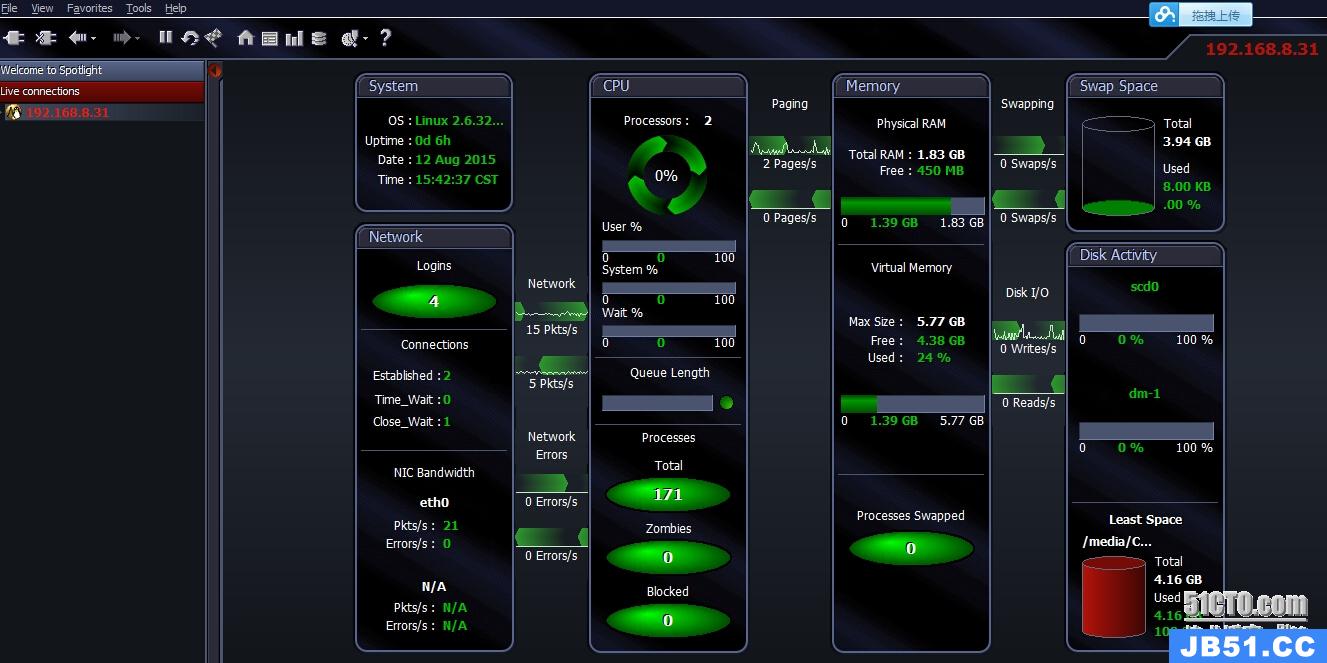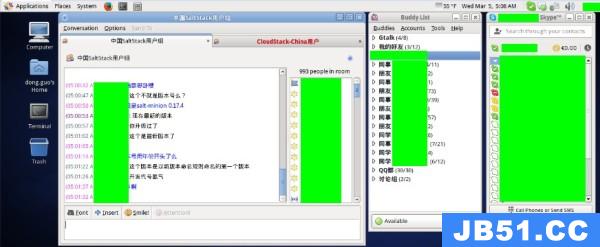CentOS7.2配置LNMP环境记录
LNMP是Linux、Nginx、MysqL(MariaDB)和PHP的缩写,这个组合是最常见的WEB服务器的运行环境之一。本文将带领大家在CentOS 7操作系统上搭建一套LNMP环境。
本教程适用于CentOS 7.x版本。
准备工作
rpm -Uvh https://dl.fedoraproject.org/pub/epel/epel-release-latest-7.noarch.rpm
rpm -Uvh https://mirror.webtatic.com/yum/el7/webtatic-release.rpm
安装 epel:
yum install epel-release
然后更新下系统:
yum update
准备工作完成,开始安装!
安装Nginx
CentOS系统模板中配置了内网源,下载速度较快,推荐使用yum安装Nginx:
sudo yum install Nginx
按照提示,输入yes后开始安装。安装完毕后,Nginx的配置文件在/etc/Nginx目录下。使用以下命令启动Nginx:
sudo systemctl start Nginx
检查系统中firewalld防火墙服务是否开启,如果已开启,我们需要修改防火墙配置,开启Nginx外网端口访问。
sudo systemctl status firewalld
如果显示active (running),则需要调整防火墙规则的配置。
修改/etc/firewalld/zones/public.xml文件,在zone一节中增加:
<zone>
...
<service name="Nginx"/>
<zone>
保存后重新加载firewalld服务:
sudo systemctl reload firewalld
您可以通过浏览器访问 http://<外网IP地址> 来确定Nginx是否已经启动。
最后将Nginx设置为开机启动:
sudo systemctl enable Nginx.service
这么Nginx就安装成功了!
安装MysqL(MariaDB)
MariaDB是MysqL的一个分支,主要由开源社区进行维护和升级,而MysqL被Oracle收购以后,发展较慢。在CentOS 7的软件仓库中,将MysqL更替为了MariaDB。
我们可以使用yum直接安装MariaDB:
sudo yum install mariadb-server
安装完成之后,执行以下命令重启MariaDB服务:
sudo systemctl start mariadb
MariaDB默认root密码为空,我们需要设置一下,执行脚本:
sudo /usr/bin/MysqL_secure_installation
这个脚本会经过一些列的交互问答来进行MariaDB的安全设置。
首先提示输入当前的root密码:
Enter current password for root (enter for none):
初始root密码为空,我们直接敲回车进行下一步。Set root password? [Y/n]
设置root密码,默认选项为Yes,我们直接回车,提示输入密码,在这里设置您的MariaDB的root账户密码。Remove anonymous users? [Y/n] 是否移除匿名用户,默认选项为Yes,建议按默认设置,回车继续。
disallow root login remotely? [Y/n]
是否禁止root用户远程登录?如果您只在本机内访问MariaDB,建议按默认设置,回车继续。 如果您还有其他云主机需要使用root账号访问该数据库,则需要选择n。Remove test database and access to it? [Y/n] 是否删除测试用的数据库和权限?
建议按照默认设置,回车继续。Reload privilege tables Now? [Y/n]
是否重新加载权限表?因为我们上面更新了root的密码,这里需要重新加载,回车。
完成后你会看到Success!的提示,MariaDB的安全设置已经完成。我们可以使用以下命令登录MariaDB:
MysqL -uroot -p
按提示输入root密码,就会进入MariaDB的交互界面,说明已经安装成功。
最后我们将MariaDB设置为开机启动。
sudo systemctl enable mariadb
安装PHP
我们可以直接使用yum安装PHP:
sudo yum install PHP56w-fpm PHP56w-MysqL PHP56w-MysqLi PHP56w PHP56w-opcache PHP56w-gd PHP56w-intl PHP56w-mbstring PHP56w-exif PHP56w-mcrypt PHP56w-openssl //把该安装的一次性装到位
安装完成后我们将PHP-fpm启动:
sudo systemctl start PHP-fpm
将PHP-fpm设置为开机启动:
sudo systemctl enable PHP-fpm
接下来需要注意了!~配置Nginx--多个站点
我给大家提供一个范本作为参考:
Nginx.conf
里面我会详细的给予中文注释
vi /etc/Nginx/Nginx.conf //编辑Nginx.conf的命令
# For more information on configuration,see: # * Official English Documentation: http://Nginx.org/en/docs/ # * Official Russian Documentation: http://Nginx.org/ru/docs/ user Nginx; worker_processes auto; error_log /var/log/Nginx/error.log; #错误日志记录的位置 pid /run/Nginx.pid; #Nginx.pid为记录Nginx主进程pid文件;切勿修改、移动 # Load dynamic modules. See /usr/share/Nginx/README.dynamic. include /usr/share/Nginx/modules/*.conf; #引入/usr/share/Nginx/modules/ 目录下的所有以.conf结尾的文件 events { worker_connections 1024; } http { log_format main '$remote_addr - $remote_user [$time_local] "$request" ' '$status $body_bytes_sent "$http_referer" ' '"$http_user_agent" "$http_x_forwarded_for"'; access_log /var/log/Nginx/access.log main; sendfile on; tcp_nopush on; tcp_nodelay on; keepalive_timeout 65; types_hash_max_size 2048; include /etc/Nginx/mime.types; default_type application/octet-stream; # Load modular configuration files from the /etc/Nginx/conf.d directory. # See http://Nginx.org/en/docs/ngx_core_module.html#include # for more information. include /etc/Nginx/conf.d/*.conf; #这句很重要,引入所有etc/Nginx/conf.d/目录下的.conf文件 #***etc/Nginx/conf.d/目录存放的就是分站点的文件(下面会给出实例代码)*** server { #由于我们的Nginx需要配置多站点,所以在此就需要注释一些东西 listen 80 default_server; listen [::]:80 default_server; #保留监听的端口 # server_name _; # root /usr/share/Nginx/PHP; # Load configuration files for the default server block. # include /etc/Nginx/default.d/*.conf; # location / { # } # error_page 404 /404.html; location = /40x.html { } error_page 500 502 503 504 /50x.html; location = /50x.html { } # location ~ \.PHP$ { # root /usr/share/PHP; # fastcgi_pass 127.0.0.1:9000; # fastcgi_index index.PHP; # fastcgi_param SCRIPT_FILENAME $document_root$fastcgi_script_name; # include fastcgi_params; # } } # Settings for a TLS enabled server. # # server { # listen 443 ssl http2 default_server; # listen [::]:443 ssl http2 default_server; # server_name _; # root /usr/share/Nginx/html; # # ssl_certificate "/etc/pki/Nginx/server.crt"; # ssl_certificate_key "/etc/pki/Nginx/private/server.key"; # ssl_session_cache shared:SSL:1m; # ssl_session_timeout 10m; # ssl_ciphers HIGH:!aNULL:!MD5; # ssl_prefer_server_ciphers on; # # # Load configuration files for the default server block. # include /etc/Nginx/default.d/*.conf; # # location / { # } # # error_page 404 /404.html; # location = /40x.html { # } # # error_page 500 502 503 504 /50x.html; # location = /50x.html { # } # } } #注意:此份Nginx.conf可以直接复制了去使用!~好用了就给博主打个赏钱!谢谢!
service Nginx start #启动Nginx service Nginx stop #停止Nginx service Nginx restart #重启Nginx sudo systemctl reload Nginx #或者执行这条
重启完毕,继续打开 http://<外网IP地址> 来确定Nginx是否已经启动
此时,服务器启动的是Nginx和apache
而且PHP-fpm默认发送到apache
所以咱们还得继续修改一下PHP-fpm
配置 PHP-fpm :
vi /etc/PHP-fpm.d/www.conf #编辑PHP-fpm配置文件
修改user和group (源代码为:user = apache group = apache)
user = Nginx group = Nginx
service PHP-fpm start #启动PHP-fpm service PHP-fpm stop #停止PHP-fpm service PHP-fpm restart #重启PHP-fpm
最后,咱们需要为Nginx添加站点了
添加站点这我先给大家一个截图,以帮助大家迅速的了解是怎么回事
大家应该看的很清楚了,猜都可以猜到,博主这一共配置了三个站点,这三个站点是怎么被Nginx引入的呢?
include /etc/Nginx/conf.d/*.conf; #这句很重要,引入所有etc/Nginx/conf.d/目录下的.conf文件 #***etc/Nginx/conf.d/目录存放的就是分站点的文件(下面会给出实例代码)***
好的,大家应该能准确理解了,如果还是理解不了的话只能缺你回去喝点三鹿了!
下面我给大家贴出Nginx站点配置文件的代码,修改修改就可以用
看代码的时候请注意看里面的路径,当然我也还是会给一定的中文注释
#这个文件是上面的qopmall.com.conf server { server_name qopmall.com www.qopmall.com;#这里就是你要绑定的域名了,空格分开 location / { root /usr/share/PHP/weixin; #这里是你站点存放的文件夹名称(也就是说,你当前这个站点的文件全部都丢在这个路径的weixin文件夹里面) index index.PHP index.html index.htm; #这里照抄即可 } # pass the PHP scripts to FastCGI server listening on 127.0.0.1:9000 # location ~ \.PHP$ { root /usr/share/PHP/weixin; #这里的配置等同于上面的那个root配置 fastcgi_pass 127.0.0.1:9000; fastcgi_index index.PHP; fastcgi_param SCRIPT_FILENAME /usr/share/PHP/weixin/$fastcgi_script_name; #这里的配置也是和上面的root配置一样 include fastcgi_params; } }
由于博主是个菜鸡,也就顺带给大家分享一下经验,老司机请绕道行驶!如果你觉得博主写得帮到了你,或者对你来说还算有用了,麻烦点个赞,土豪直接打赏就行,我不反对!see you!~



